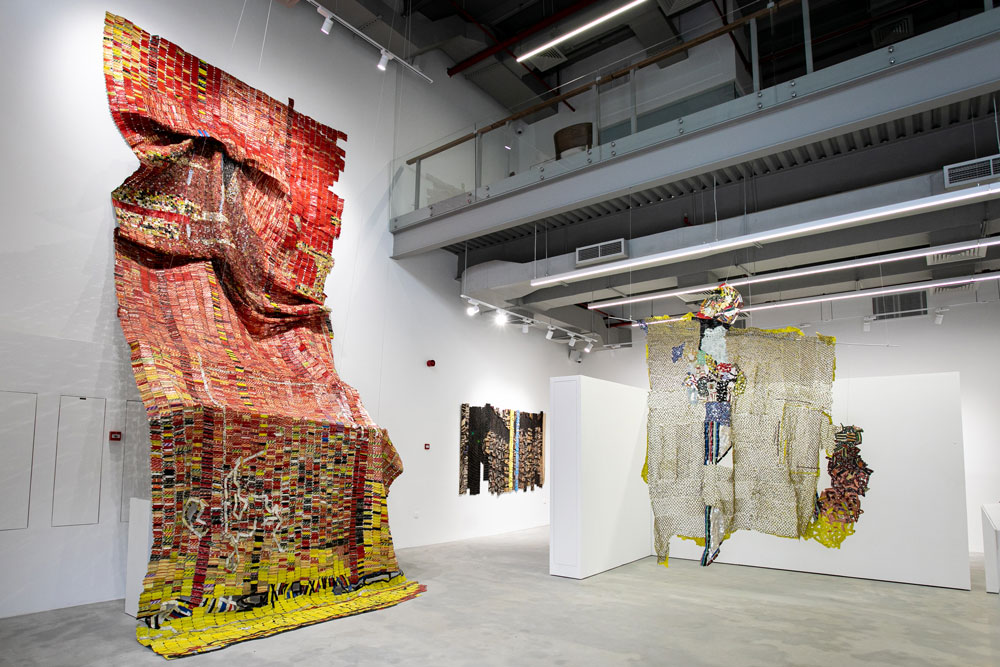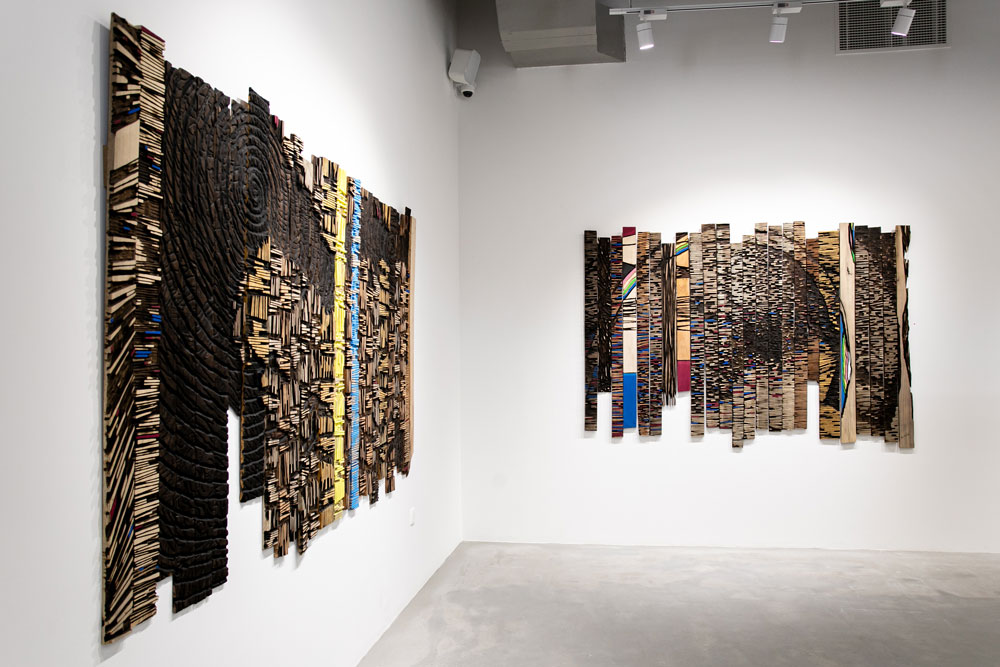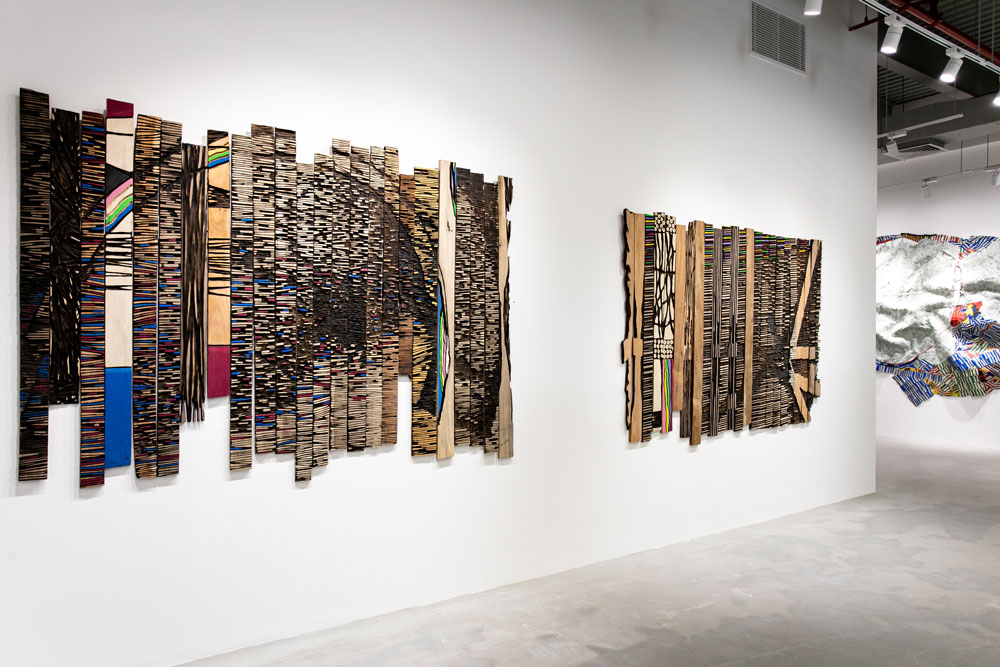At the turn of every material exploration in Anatsui’s journey as an artist—from clay, wood, textile, glass, metal— it is this material metamorphosis of the shard and its relationship to Anatsuian sculpture that continues to offer the world yet another angle or quality unexplored in the universal, complex narrative of fragmentation and kinship. To many, turning the spotlight in Shard Song onto Anatsui’s woodworks after twenty-four years of global reverence for his metallic hanging sculptures may appear like a ‘reunion’ with an old friend. Yet El’s relationship with wood has never wavered, persistently deepening since the late 1960s, cumulatively absorbing and translating lessons from other media to evolve the conceptual freedom that emerges in his new wooden sculptures. Sixty years on from his initial explorations with clay, Anatsui has begun to capture the transient, dynamic quality and malleability that he developed in the three-dimensional Broken Pots sculpture series with earthen media. As a two-dimensional wall sculpture, the challenge of malleability is accomplished in a wide range of rich, micro-scale topographical variations on the surface of half-inch thick wooden panels. Ranging from well-defined, triangulated-patterns as seen in DNA to the fluid-like shards dissipating into space in Rainbow Hues, the surface of tropical Ghanaian hardwood panels are rendered pliable and receptive to the nuances of human hand.
The slow, iterative nature of the sculptural process is revealed in the close relationship of wood with hand. Unlike the larger vertical panels huddled shoulder to shoulder, that have been cut with a mechanical saw and whose wounded boundaries are hidden from view, it is the hand that processes the violence that begins on the panel edge, to the materials interior and finally to the surface. Carved, burnt, sanded, and brushed iteratively by the human hand, the hardwood medium is patiently shaped. Over a ten-month period, Anatsui wields again and again, the power of time, rest, and renewed vision, to capture the minute agency and response of material to force. What begins as varied widths of vertical wooden panels arranged on the floor, is transformed through a rhythmic arrangement on the studio’s wall. Calibrated shifts in the vertical height of the panels assembled together, communicate a sense of their vulnerability to force at this scale. As if the inhalation of clean, smooth cuts made by the mechanical saw along their long edges, have eventually exhaled a quivering quality of their own when placed next to each other. Perhaps this is unique to the wood panel when reduced to a flat, long rectangular module, that the initial effect of an act of violence become so clearly expressed in the collective assembly.
At this scale, one experiences a distinct manifestation of shard that contrasts with the more obvious smaller-scale shards generated on the sculpted surface that greets the viewer’s eye. Here, the wound of each wooden panel’s edge is powerfully controlled, with its entire length exposed and touching that of its neighbor. This absorption through touch and proximity continues to activate and inform how the wooden canvas is shaped and changed over time. Much like an ever-shifting puzzle, nothing is frozen in Anatsui’s process, and no relationship between module is impossible until a clear bonding language emerges between them. If one seeks to explore the nuances in Anatsui’s language of rupture, it is here that the language of trauma not spoken, yet sedimented in the material body is masterfully induced. The magic in Anatsui’s works rests in this multimodal, multiplanar experience –what appears to be mute from one vantage point, is simultaneously revealed as undergoing exponential possibilities in response to force.
Force is always rendered present and powerful in Anatsui’s work—be it in the direct, blunt trauma of mechanical saw on wood or in the anticipated freedom of gravity acting on the hung sculpture. Over a six decade-long meditation on the language of causality, in Shard Song Anatsui opens the door to the expressive heterogeneity of force across three new wood sculptures. In the Keyboard of Life, the directionality of a singular convergent force moves horizontally across the entire sculpture. Pre-convergent forces are distinguished by regions of bare tropical wood culminating at a point, after which divergent forces are expressed as deeper carved patterns and charred surfaces of topographical richness. In Ancient Text, this language of force is embodied as two powerful circular eddies carved into the surface of the hardwood. Typically caused in nature by the countermovement of fluids to the prevailing current, the intense transfer of energy from the eddy is distributed feverishly in the vertical and horizontal kinetic movement of shards, appearing as energetic collisions with each other. Conversely in Rainbow Hues, a gentle distribution of force emanates from a rainbow that arches across seventeen vertical wooden pieces. Closely packed shards slide and slip against each other, generating a fluidic absorption and transfer of force throughout its body.
Multiple planes of movement are simultaneously observed from the sculptures’ front elevations, generating varying degrees of depth in these layered compositions. In Keyboard of Life, we observe the insertion of vertically patterned and bare panels into the dominant family of horizontally shards. Yet these vertical elements do not appear to interrupt the vector of horizontal movement, in so much as they work to index time and speed of such forces. Regions of the undulating charred topography, carefully carved into thin horizontal slivers evoke the qualitative experience of force – of its changing pressures, of light and dark, of density and emptiness. Tonal arrays of yellow, green, purple, and pink illuminate a vector of shards at the top of the sculpture almost illuminating as a beam of sunlight would, the presence of particles within seemingly invisible force. The complexity of this multiplanar approach emerges in Ancient Text, in viewing the circular spiral of the eddy and the haphazard grid of horizontal and vertical shard-like carvings. Here it is almost as if a region of space above or in front of the eddy has been cut away from to reveal a different language of dimensional movement in relation to the eddy. It is at the threshold of the two—from circular to orthogonal movement—that a careful, complex translation of forces occur. Neither escape from this threshold the same. Within the circular rings, emerge patterns of deep wrinkles or cracks, and conversely, charred reliefs permeate and become part of the orthogonal patterned carvings. This contrast in pattern choices again endows us with an appreciation of time—of wrinkling as an indicator of the ancient quality of such forces and the shorter, energetic orthogonal vibrational patterns as a reminder of the present. The bright splash of yellow and blue across two vertical panels jolt us into the present and balance our attention in relation to the depth of the charred spiral.
Across all four wooden sculptures, it is this unselfconscious experimentation with color tones that we observe the growing pulse of Anatsui’s uncensored freedom. Relative to his woodworks in the 1990s, that relied on the rich natural hues of tropical hardwood and the charred black, Anatsui’s steady exploration in the use of pigment continues to evolve. Infused into the language and form of fragments, fragmenting forces, and their surrounding environment, we witness a shift in Anatsui’s control of color away from the characteristically bright and bold colors inspired by kente textile traditions to the now more tonal adjustments of color. Perhaps this experimentation tone is in response to color in the Ghanaian tropical hardwood itself. Anatsui’s return home to Ghana from Nsukka, and his activation of a new production studio in Tema, Ghana has also ushered in a renewed exploration of materials from the Ghanaian ecology. While there are many parallels in the Ghanaian and Nigerian domestic and industrial material inventory, differences in the types of hardwood available from these respective ecologies provoke Anatsui’s exploration in color. Although Nsukka itself experiences a tropical savannah climate, and therefore reduced diversity in tree populations, Anatsui’s access to a rich, variety of hardwoods from the surrounding forest region offered a wide range of colors intrinsic to the wood itself –from the reds of camwood to yellows, and even to pure white. The much-reduced color range of Ghanaian hardwoods, constrained to the middle region of yellows, gives rise to an opportunity to play with the tonal variation of colored pigments as another dimension for expression. Together with the quirky tonal range of pigments that are painted onto bare wood surface and carved reliefs, the qualitative experiences of natural phenomena are woven into the narrative.












